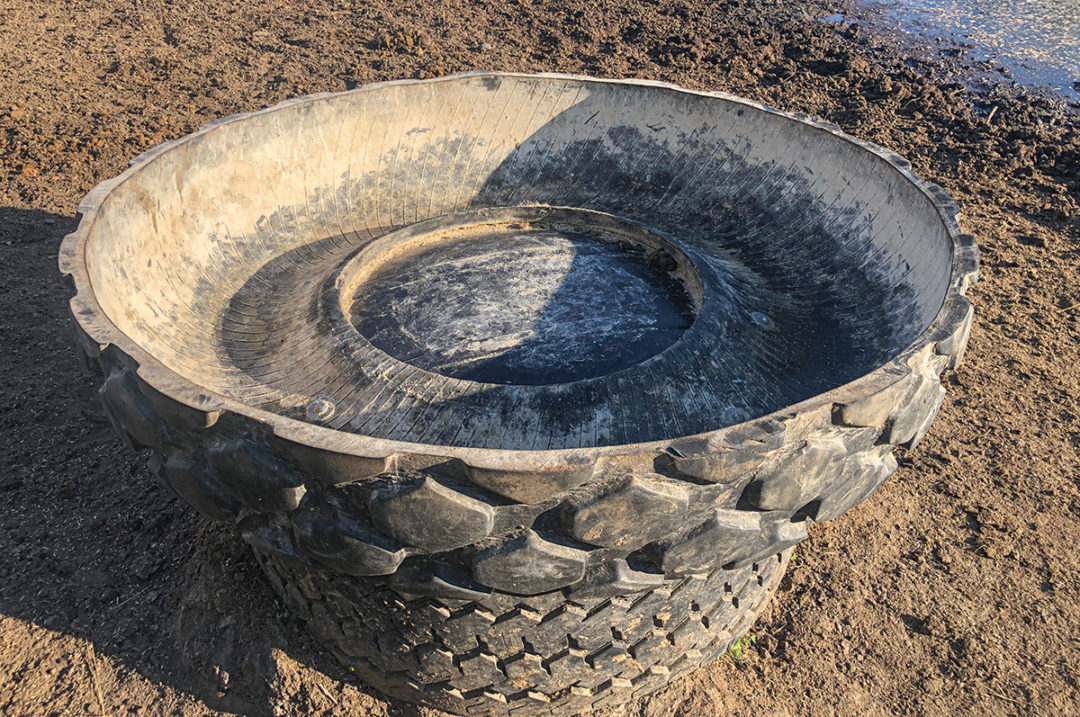My husband, Gregory, and I raise both horses and cows, so we have quite a number of animals to feed. We often supplement our nursing mares and cows with our home-raised oats in the spring before they can go on green grass. Both the cows and horses can be quite pushy when they are eating, so we needed a way to feed several animals safely in a relatively small space.
With the mares, I had been using several small rubber tubs, but they always seemed to get stepped in and dumped out or I had to chase them all down and try to empty them of mud before putting the new feed in. With the cows, we had a few 10-foot metal feeders, but we had too many animals and not enough feeders.
We always try to use what we have on hand instead of buying new, so after some thought Gregory came up with a plan: tire feeders. With our equipment, we always have a few tires on hand. When we used up all of our old tires, we asked the tire shops if they had a wrecked tire, and they would give them to us if they had what we were looking for.
For our new feeders, Gregory chose a diamond-tread, large-diameter tire which happened to be a combine tire from a John Deere 7720. It did not have any steel in it, so there was nothing for the horses or cows to get cut on. Also, the combine tire was wide and when Gregory cut it in half with a skill saw, it created a deep dish for the grain to sit in (versus a rear tractor tire that would be shallower if cut in half). This alone would have been very usable, as a good amount of grain will fit inside the ring of the tire, thus keeping it off of the ground and eliminating the problem of the rubber tubs being flipped over or filled with mud and water.
Another bonus to the tire feeder was that the tire had no sharp edges and it had some give to it if an animal slipped or was pushed into it. One year, we had a 2-year-old colt get pushed into the long metal feeder, and he ended up with a lump on his cannon bone. It healed eventually but was a very noticeable blemish that made him difficult to sell. Also, even with bulls – who can be very hard on things – the tire feeder didn’t get wrinkled or break. If an animal stepped in it or pushed on it, it just sprang back into place.
Gregory went a step further, though, and bolted a front tire from a tractor underneath the combine tire. He drilled some holes through both of the tires on the inside lip and put a bolt through with a washer on both sides so the bolt would never tear out. This addition lifted the feeder off the ground, and thus it was farther away from the mud in the spring.
Gregory has used front tractor tires as well as heavy semi tires under the combine tire. These types of tires are stiff and do not collapse under the weight of the bigger tire. The bottom tire also helps maintain the dish of the top tire by holding up the bead in the middle.
In the center of the tire, he bolted a lid from a plastic barrel. This kept the grain from being pushed into the center of the tire where the cows couldn’t reach it. After drilling a couple holes in the lid in order for any snow or rain to drain away, it also worked as a good place to put a salt or mineral block. It keeps it off of the ground and out of the mud. Even if the cows get really pushy, the worst thing that happens is that the block is pushed into the tire and can easily be recovered and placed back in the center.
We usually feed grain in the tire feeder and put a mineral block in the center, but we have a friend who has used them to feed small square-baled hay to a few animals. It can also be handy in feeding loose mineral and salt, as many animals can eat at the same time.
My father-in-law, John, had the good idea of also bolting a short chain across the middle of the combine tire to aid with transportation of the feeder. Gregory can either pick it up by putting the forks of the skid steer under the bottom tire, or he can hook the chain on one of the forks. With the tractor, he can put a short chain through the chain on the tire feeder and hook it on one of the hooks on the bucket of the tractor.
Whether you use your own tires or pick some wrecked ones up from the local tire shop, you can build an animal-friendly and very usable feeder in which to feed hay, loose salt and mineral, or grain and have a dry place to put your salt or mineral block.






